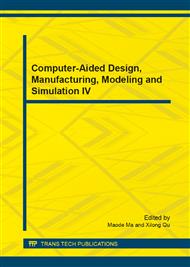p.685
p.689
p.693
p.698
p.703
p.708
p.713
p.717
p.721
Intelligent Robot Motion Control System Based on Immune Genetic Algorithm
Abstract:
The robot's motion control system is the core technology of intelligent robot. In this paper based on immune genetic algorithm, we improve the intelligent robot control system, and design the intelligent robot action output system with adjustable ratio combined with the PID algorithm. The system has the adaptive adjustment function, by adjusting the proportional coefficient P, which can reduce the output error of the system, improve the adaptability of the system and accelerate the speed of motion control. Finally, we use Siemens S7-200 series products to simulate the action output, and obtain the output time and residual of action under different proportional coefficient P by simulation. It provides the technical reference for the research on control algorithm of intelligent robot.
Info:
Periodical:
Pages:
703-707
Citation:
Online since:
October 2014
Authors:
Price:
Сopyright:
© 2014 Trans Tech Publications Ltd. All Rights Reserved
Share:
Citation:


